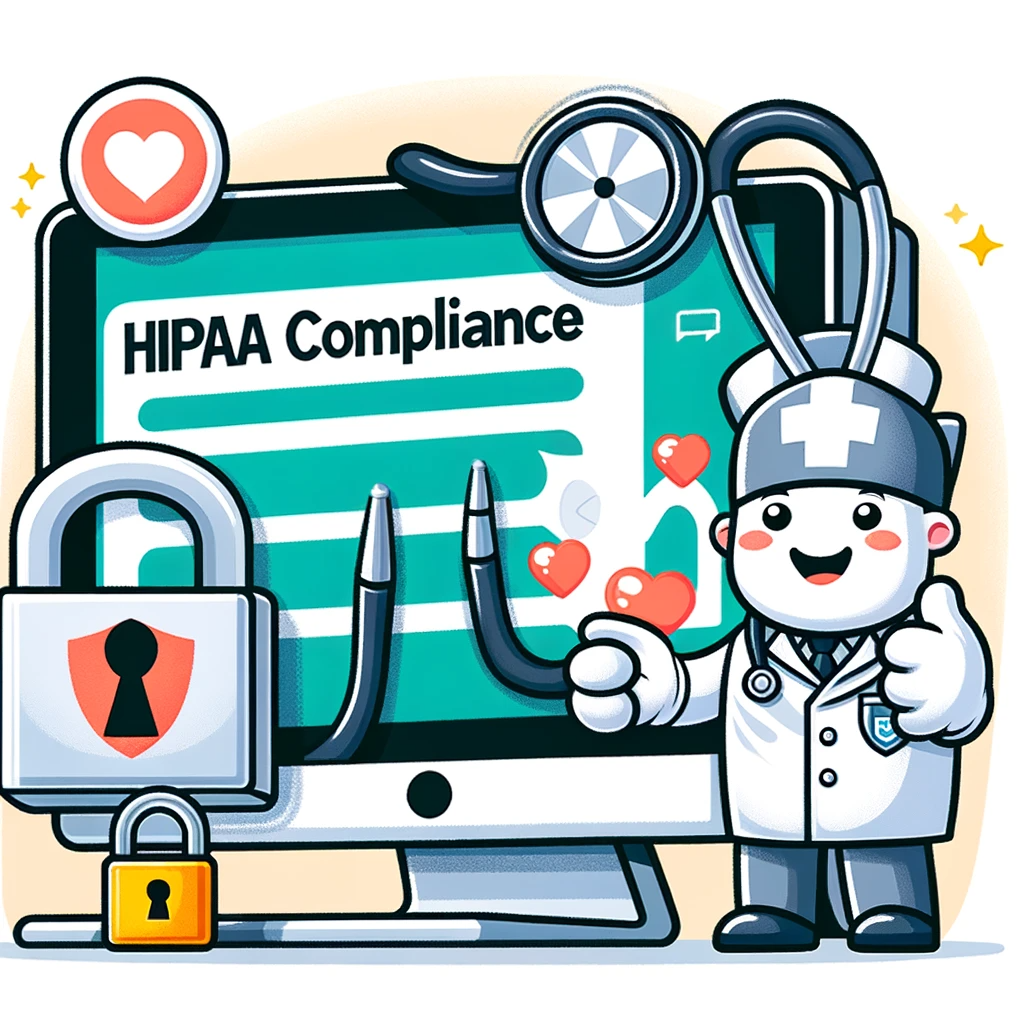
The Ultimate HIPAA-Compliant Website Checklist: Creating a HIPAA-Compliant Web Presence with WordPress
This post may contain affiliate links, which means I may receive a commission if you click a link and purchase something that I have recommended. Thank you!
The Health Insurance Portability and Accountability Act (HIPAA), a fundamental framework in the healthcare sector, sets the standard for protecting sensitive patient data. However, when it comes to websites, HIPAA's guidelines become less clear. Unlike other areas it covers, HIPAA doesn't specifically address website compliance. This leaves many healthcare providers and associated entities in a quandary about how to make their online presence compliant, especially when using popular website platforms like WordPress.
The essence of HIPAA's application to websites lies in its Security Rule, which requires safeguards to ensure the confidentiality, integrity, and availability of electronic Protected Health Information (ePHI). This broad requirement means any website that handles ePHI – whether a bespoke development or one created using a platform like WordPress – must adhere to these standards. This encompasses not only the website's content but also the way it's managed and hosted.
Challenges in Making Your Website Meet HIPAA Compliance with WordPress
Creating a HIPAA-compliant website using WordPress is particularly challenging. While WordPress is lauded for its ease of use and flexibility, it wasn't designed with the stringent requirements of HIPAA compliance in mind. A standard WordPress installation, right out of the box, doesn't meet HIPAA standards.
This lack of inherent compliance doesn't mean WordPress can't be used for healthcare websites; it simply means that achieving HIPAA compliance requires extra steps and vigilance. The platform needs substantial customization and the addition of specific features to protect ePHI adequately. From hosting considerations to data encryption and access control, every aspect of a WordPress site needs scrutiny and potential modification.
Moreover, WordPress's popularity and open-source nature make it a frequent target for cyber threats. This aspect further complicates its use for HIPAA-compliant websites. Security vulnerabilities in WordPress, or in the myriad plugins available for it, can pose significant risks to ePHI, necessitating ongoing vigilance and maintenance.
Understanding HIPAA Regulations: Essential Requirements for a HIPAA Compliant Website
To delve deeper into creating a HIPAA-compliant WordPress site, understanding the various rules and regulations of HIPAA is crucial. The HIPAA Privacy Rule and the HIPAA Security Rule are particularly relevant to website compliance. The Privacy Rule sets the boundaries for the use and disclosure of ePHI, emphasizing patient rights and the integrity of their personal health information. The Security Rule, on the other hand, lays out the standards for protecting ePHI that is held or transferred in electronic form.
Specifically, Protected Health Information (PHI) under HIPAA includes a wide range of identifiers. From names and addresses to more obscure data like IP addresses and vehicle identifiers, any information that can be linked to an individual's health status is covered. This broad definition necessitates careful consideration of the types of information collected and stored on healthcare websites.
In the next parts of this series, we'll delve into the specifics of designing a HIPAA-compliant website with WordPress, focusing on server requirements, hosting considerations, and ensuring ongoing compliance. By understanding and adhering to these guidelines, healthcare providers and associated entities can create a digital presence that not only serves their needs but also aligns with the critical standards of HIPAA.
Key Elements of HIPAA-Compliant Website Design and Web Development
When designing a HIPAA-compliant website using WordPress, it's paramount to integrate HIPAA's security and privacy standards right from the outset. The design process must prioritize the confidentiality, integrity, and availability of Protected Health Information (PHI). This means incorporating specific access controls to prevent unauthorized access to PHI, not just within the website’s content, but also in the WordPress administration panel.
In addition to restricting access, audit controls are essential. These controls involve logging all access to the site and any activity related to ePHI. This step is critical in tracking who accesses the information and what they do with it, which is a core requirement of HIPAA. Integrity controls are also necessary to prevent unauthorized alterations or deletions of PHI, thereby ensuring data accuracy and reliability.
Furthermore, transmission security controls are crucial for websites dealing with PHI. This involves ensuring that any PHI uploaded to the site is encrypted during transit and properly secured at rest, be it on a third-party server or a covered entity’s web server. The aim is to protect PHI from unauthorized access or breaches during its entire lifecycle on the website.
Selecting HIPAA Compliant Web Hosting: Key Considerations for Your HIPAA Website
The next critical aspect is the server and hosting environment for your WordPress site. Server hardening is a process that involves reinforcing the server's security to meet the technical requirements of HIPAA. This includes regular updates to WordPress and PHP, strong password policies, and employing secure file transfer protocols like sFTP. Special attention should be given to file permissions and system services to prevent unauthorized changes or access.
Choosing the right HIPAA-compliant hosting provider is equally vital. Such a provider will offer an infrastructure that includes necessary physical security controls, encrypted data backup plans, disaster recovery solutions, and extensive activity logging. These features ensure that your hosting environment adheres to HIPAA standards and safeguards PHI effectively. Our preferred hosting for HIPAA compliancy is HIPAA Vault.
Securing Web Forms and Data Transmission: Making A HIPAA-Compliant Web
For websites that collect health information through forms, it's essential to ensure these forms and their data transmission methods are HIPAA-compliant. This means using forms that protect individually identifiable health information against unauthorized access and potential breaches. A critical aspect of this is SSL certificate encryption (TLS), which secures all data in motion between the client device and the server, ensuring the transition from HTTP to the more secure HTTPS protocol.
In the final part of this series, we will explore the implementation and maintenance of HIPAA compliance in a WordPress environment. This includes a detailed checklist for compliance, ongoing security measures, and the importance of continuous monitoring and updating to ensure the website remains aligned with HIPAA standards. Learn more about HIPAA compliant forms at the HIPAA Compliancy Group
Implementing and Maintaining HIPAA Compliance: A Comprehensive Checklist for Your Website
Creating a HIPAA-compliant WordPress website is a multifaceted process that requires careful planning and implementation. It is crucial to follow a structured approach to ensure all aspects of HIPAA regulations are addressed.
The Complete HIPAA Compliance Checklist for WordPress
-
Risk Analysis: Before using any electronic Protected Health Information (ePHI), perform a comprehensive risk analysis. This step is essential in identifying potential vulnerabilities and reducing risks to a reasonable and acceptable level.
-
HIPAA-compliant Hosting Service: Secure a hosting service that specifically caters to HIPAA compliance. However, remember that merely hosting your site with a HIPAA-compliant provider does not automatically guarantee compliance. It is essential to establish and maintain the necessary access, audit, and integrity controls, along with implementing safeguards for data at rest and in transit.
-
Security Scans and Plugin Management: Regularly conduct security scans of your site to check for vulnerabilities. Use plugins from trusted sources, ensure they are routinely updated, and keep your WordPress installation up to date.
-
Security Plugins: Employ security plugins like Wordfence to enhance the website's defense against potential cyber threats.
-
ePHI Management: Store any ePHI outside of WordPress and ensure strong firewall management. This includes routine device health checks and log monitoring.
-
Strong Passwords and Authentication Measures: Implement strong passwords and admin account names. Utilize two-factor authentication for administrator accounts to bolster security.
-
Encryption of Data in Transit: Ensure that all data collected via web forms is encrypted during transmission. This is crucial for protecting the integrity and confidentiality of ePHI.
-
Business Associate Agreements: Obtain necessary business associate agreements with all service providers or plugin developers who require access to ePHI or whose software interacts with ePHI.
Continuous HIPAA Compliance: Ensuring Ongoing Security for Your HIPAA Website
Maintaining HIPAA compliance is an ongoing task. It requires continuous monitoring and updating of the website to address emerging security threats and changes in regulatory standards.
-
Multi-Factor Authentication: Implement managed multi-factor authentication systems for access control. This helps in verifying user identities and blocking high-risk devices.
-
Regular Off-Site Backups: Set up regular off-site backups for data redundancy and disaster recovery. This ensures the availability of ePHI even in the event of unforeseen incidents.
-
Continuous Monitoring: Keep a close watch on the website's security posture. Update WordPress and its plugins regularly, and conduct periodic audits to ensure ongoing compliance with HIPAA standards.
The Critical Importance of Maintaining HIPAA Compliance in Web Development
Adhering to HIPAA standards in a WordPress environment is not just about setting up a compliant website; it's about continuous vigilance and maintenance. The healthcare industry's digital landscape is ever-evolving, and so are the threats to data security. Therefore, it is vital for healthcare organizations and their service providers to stay proactive in protecting sensitive patient data. By rigorously implementing and maintaining the practices outlined above, organizations can ensure their WordPress websites not only meet HIPAA compliance but also provide a secure, trustworthy digital space for their patients and partners.
Frequently Asked Questions
To ensure your website is HIPAA compliant, follow these steps:
-
Understand HIPAA Requirements: Familiarize yourself with HIPAA regulations, particularly the Privacy and Security Rules.
-
Risk Analysis: Conduct a thorough risk analysis to identify potential vulnerabilities regarding ePHI.
-
Hosting and Server Security: Choose a HIPAA-compliant hosting provider and ensure server hardening to protect data.
-
Access Control: Implement strict access controls to prevent unauthorized access to PHI.
-
Encryption: Encrypt data in transit, especially PHI, to ensure secure data transmission.
-
Audit Controls: Set up systems to log access to PHI and monitor activities on the website.
-
Data Backup and Recovery: Have encrypted data backup plans and disaster recovery solutions.
-
Business Associate Agreement (BAA): If using third-party services, ensure they sign a BAA.
-
Regular Updates and Monitoring: Keep your website, plugins, and security measures up to date and monitor them regularly.
How do I make a Web form HIPAA compliant?
To make a web form HIPAA compliant:
-
Encryption: Ensure all data transmitted via the form is encrypted.
-
Access Control: Limit access to the data collected through the form.
-
Audit Trails: Implement tracking and logging for any access or modifications to the form data.
-
Secure Hosting: Host the form on a HIPAA-compliant server.
-
Data Storage: Store form data securely, adhering to HIPAA regulations.
-
BAA with Service Providers: If using third-party form services, have them sign a BAA.
What website builder is HIPAA compliant?
No website builder is inherently HIPAA compliant, but some are more conducive to creating a compliant site. Website builders that offer robust security features, customization, and the ability to integrate with HIPAA-compliant hosting services can be used to build a HIPAA-compliant website. Custom-built websites are often recommended for strict compliance.
Is GoDaddy website builder HIPAA compliant?
GoDaddy's website builder itself is not HIPAA compliant. While you can use GoDaddy hosting services for a website, achieving HIPAA compliance requires additional steps like encryption, secure data storage, and potentially a BAA if GoDaddy is handling ePHI on your behalf.
How do I make an online form HIPAA compliant?
To make an online form HIPAA compliant:
-
Encryption: Use SSL/TLS encryption for data transmitted by the form.
-
Secure Data Storage: Store the collected data securely and in compliance with HIPAA standards.
-
Access Control: Implement strong access controls and authentication for those who can view or edit the form data.
-
Logging and Monitoring: Keep logs of all access and changes to the form data.
-
BAA with Vendors: Ensure any third-party vendors involved with the form sign a BAA.
How do I create a HIPAA compliant website?
Creating a HIPAA compliant website involves:
-
Understanding HIPAA Rules: Familiarize yourself with the HIPAA Privacy and Security Rules.
-
Secure Hosting and Server: Use HIPAA-compliant hosting and ensure server security.
-
Encrypt Data Transmissions: Encrypt all PHI transmitted to or from the website.
-
Implement Strong Access Controls: Restrict and monitor access to PHI.
-
Regular Audits: Conduct regular audits for security vulnerabilities.
-
BAA Agreements: Sign BAAs with any third-party service providers.
-
Continuous Monitoring and Updates: Regularly update and monitor the website for new threats or vulnerabilities.
Is Squarespace HIPAA compliant?
As of my last update, Squarespace is not HIPAA compliant. They do not sign BAAs, which is a requirement for handling ePHI. It is recommended to choose a platform or service that explicitly supports HIPAA compliance.
How do I know if my website is HIPAA compliant?
To know if your website is HIPAA compliant:
-
Audit Your Website: Regularly audit your website against HIPAA requirements, focusing on data security, encryption, access controls, and audit logs.
-
Review Hosting and Data Storage: Ensure your hosting service is HIPAA-compliant and that all PHI is securely stored and encrypted.
-
Check BAAs: Make sure you have BAAs in place with all vendors handling ePHI.
-
Stay Updated on Regulations: Keep abreast of HIPAA regulations and update your compliance strategies accordingly.


